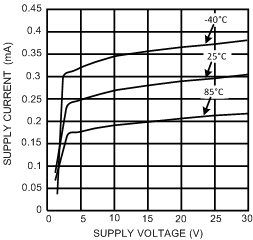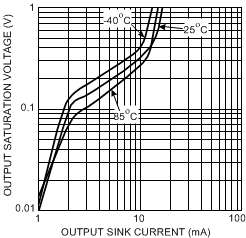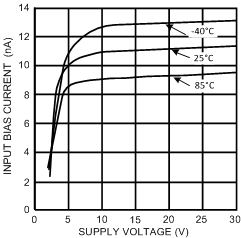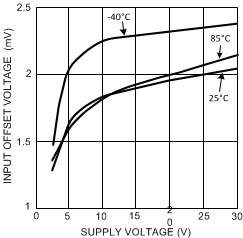SNOS977F May 2001 – May 2016 LM397
PRODUCTION DATA.
6 Specifications
6.1 Absolute Maximum Ratings
over operating free-air temperature range (unless otherwise noted)(1)(2)| MIN | MAX | UNIT | ||
|---|---|---|---|---|
| VIN differential | 30 | 30 | V | |
| Supply voltages | ±15 | 30 | V | |
| Voltage at input pins | −0.3 | 30 | V | |
| Junction temperature(3) | 150 | ºC | ||
| Soldering information | Infrared or Convection (20 sec.) | 235 | ºC | |
| Wave Soldering (10 sec.) | 260 | ºC | ||
| Storage Temperature, Tstg | −65 | 150 | ºC | |
(1) Stresses beyond those listed under Absolute Maximum Ratings may cause permanent damage to the device. These are stress ratings only, which do not imply functional operation of the device at these or any other conditions beyond those indicated under Recommended Operating Conditions. Exposure to absolute-maximum-rated conditions for extended periods may affect device reliability.
(2) If Military/Aerospace specified devices are required, please contact the TI Sales Office/ Distributors for availability and specifications.
(3) The maximum power dissipation is a function of TJ(MAX), RθJA. The maximum allowable power dissipation at any ambient temperature is PD = (TJ(MAX) – TA)/ RθJA . All numbers apply for packages soldered directly onto a PCB.
6.2 ESD Ratings
| VALUE | UNIT | |||
|---|---|---|---|---|
| V(ESD) | Electrostatic discharge | Human body model (HBM), per ANSI/ESDA/JEDEC JS-001(1)(2) | ±2000 | V |
| Machine Model(1)(2) | ±200 | |||
(1) JEDEC document JEP155 states that 500-V HBM allows safe manufacturing with a standard ESD control process.
(2) Human Body Model, applicable std. MIL-STD-883, Method 3015.7. Machine Model, applicable std. JESD22-A115-A (ESD MM std. of JEDEC) Field-Induced Charge-Device Model, applicable std. JESD22-C101-C (ESD FICDM std. of JEDEC).
6.3 Recommended Operating Conditions
| MIN | MAX | UNIT | ||
|---|---|---|---|---|
| Supply voltage, VS | 5 | 30 | V | |
| Temperature(1) | −40 | 85 | °C | |
(1) The maximum power dissipation is a function of TJ(MAX), RθJA. The maximum allowable power dissipation at any ambient temperature is PD = (TJ(MAX) – TA)/ RθJA . All numbers apply for packages soldered directly onto a PCB.
6.4 Thermal Information
| THERMAL METRIC(1) | LM397 | UNIT | |
|---|---|---|---|
| DBV (SOT-23) | |||
| 5 PINS | |||
| RθJA | Junction-to-ambient thermal resistance(2) | 186 | °C/W |
| RθJC(top) | Junction-to-case (top) thermal resistance | 92.8 | °C/W |
| RθJB | Junction-to-board thermal resistance | 38.9 | °C/W |
| ψJT | Junction-to-top characterization parameter | 5.6 | °C/W |
| ψJB | Junction-to-board characterization parameter | 38.4 | °C/W |
(1) For more information about traditional and new thermal metrics, see the Semiconductor and IC Package Thermal Metrics application report, SPRA953.
(2) The maximum power dissipation is a function of TJ(MAX), RθJA. The maximum allowable power dissipation at any ambient temperature is PD = (TJ(MAX) – TA)/ RθJA . All numbers apply for packages soldered directly onto a PCB.
6.5 Electrical Characteristics
Unless otherwise specified, all limits are ensured for TA = 25°C, VS = 5 V, V− = 0 V, VCM = V+/2 = VO.| PARAMETER | TEST CONDITIONS | MIN(2) | TYP(1) | MAX(2) | UNIT | ||
|---|---|---|---|---|---|---|---|
| VOS | Input offset voltage | VS = 5 V to 30 V, VO = 1.4 V, VCM = 0 V |
TA = 25ºC | 2 | 7 | mV | |
| At the temperature extremes | 10 | ||||||
| IOS | Input offset current | VO = 1.4 V, VCM = 0 V | TA = 25ºC | 1.6 | 50 | nA | |
| At the temperature extremes | 250 | ||||||
| IB | Input bias current | VO = 1.4 V, VCM = 0 V | TA = 25ºC | 10 | 250 | nA | |
| At the temperature extremes | 400 | ||||||
| IS | Supply current | RL = open, VS = 5 V | 0.25 | 0.7 | mA | ||
| RL = open, VS = 30 V | 0.3 | 2 | |||||
| IO | Output sink current | VIN+ = 1 V, VIN− = 0 V, VO = 1.5 V | 6 | 13 | mA | ||
| ILEAKAGE | Output leakage current | VIN+ = 1 V, VIN− = 0 V, VO = 5 V | 0.1 | nA | |||
| VIN+ = 1 V, VIN− = 0 V, VO = 30 V | 1 | µA | |||||
| VOL | Output voltage low | IO = −4 mA, VIN+ = 0 V, VIN− = 1 V |
TA = 25ºC | 180 | 400 | mV | |
| At the temperature extremes | 700 | ||||||
| VCM | Common-mode input voltage range | VS = 5 V to 30 V(3) | TA = 25ºC | 0 | VS – 1.5 | V | |
| At the temperature extremes | 0 | VS – 2 | |||||
| AV | Voltage gain | VS = 15 V, VO = 1.4 V to 11.4 V, RL > = 15 kΩ connected to VS |
120 | V/mV | |||
| tPHL | Propagation delay (high to low) |
Input overdrive = 5 mV RL = 5.1 kΩ connected to 5 V, CL = 15 pF |
900 | ns | |||
| Input overdrive = 50 mV RL = 5.1 kΩ connected to 5 V, CL = 15 pF |
250 | ||||||
| tPLH | Propagation delay (low to high) |
Input Overdrive = 5 mV RL = 5.1 kΩ connected to 5 V, CL = 15 pF |
940 | µs | |||
| Input overdrive = 50 mV RL = 5.1 kΩ connected to 5 V, CL = 15 pF |
440 | ns | |||||
(1) Typical values represent the most likely parametric norm as determined at the time of characterization. Actual typical values may vary over time and will also depend on the application and configuration. The typical values are not tested and are not specified on shipped production material.
(2) All limits are specified by testing or statistical analysis.
(3) The input common-mode voltage of either input should not be permitted to go below the negative rail by more than 0.3V. The upper end of the common-mode voltage range is VS – 1.5 V at 25°C.
6.6 Typical Characteristics
TA = 25°C. Unless otherwise specified. Figure 1. Supply Current vs Supply Voltage
Figure 1. Supply Current vs Supply Voltage
 Figure 3. Output Saturation Voltage vs Output Sink Current
Figure 3. Output Saturation Voltage vs Output Sink Current
 Figure 2. Input Bias Current vs Supply Current
Figure 2. Input Bias Current vs Supply Current
 Figure 4. Input Offset Voltage vs Supply Voltage
Figure 4. Input Offset Voltage vs Supply Voltage